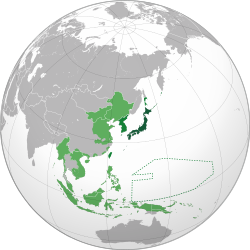ژاپون ایمپیراتورلوغو
Empire of Japan (official) Greater Japanese Empire (literal) | |
|---|---|
| ۱۸۶۸–۱۹۴۷ | |
| شوعار: 五箇条の御誓文 "Charter Oath" ("The Oath in Five Articles") in Meiji era 八紘一宇 "Hakkō ichiu" ("The World Under One Roof") or ("All Eight Corners of the World") in Showa era | |
میلی مارش:
| |
 The Empire of Japan in 1942
| |
| پایتخت | Tokyo |
| عۆموُمی دیللر | ژاپون دیلی |
| دین | De jure: none De facto: State Shinto[nb ۱] Other: Buddhism |
| دؤولت | Daijō-kan[۴] (1868–1885) مشروطیت (1890–1947)[۵] One-party military dictatorship (1940–1945) |
| Emperor | |
• ۱۸۶۸–۱۹۱۲ | Meiji (Mutsuhito) |
• ۱۹۱۲–۱۹۲۶ | Taishō (Yoshihito) |
• ۱۹۲۶–۱۹۴۷ | Shōwa (Hirohito) |
| Prime Minister | |
• ۱۸۸۵–۱۸۸۸ | Itō Hirobumi (first) |
• ۱۹۴۶–۱۹۴۷ | Shigeru Yoshida (last) |
| قانون اوقانی | Imperial Diet |
| House of Peers | |
| House of Representatives | |
| تاریخی دؤنم | Meiji, Taishō, Shōwa |
| January 3, 1868[۶] | |
| ۲۹ نوْوامبر ۱۸۹۰ | |
| ۱۸۹۴ | |
| ۱۰ فئوریه ۱۹۰۴ | |
| ۱۹۴۱–۱۹۴۵ | |
| ۲ سپتامبر ۱۹۴۵ | |
| May 2, 1947[۵] | |
| اراضی | |
| 1938[۷] | لوآ خطاسیماژول:Convert-ین 1851-جی/جو خطینده: attempt to index local 'en_value' (a nil value). |
| جمعیت | |
• ۱۹۲۰ | 77,700,000a |
• ۱۹۴۰ | 105,200,000b |
| پول واحیدی | ژاپون یئنی، Korean yen, Taiwanese yen, Japanese military yen |
| |
ژاپون ایمپیراتورلوغو (. 大日本帝國 دای نیپپون تئیکوکو، بؤیوک ژاپون ایمپیراتورلوغو) - ۳ ژانویه ۱۸۶۸-جی ایلدن ۳ مئی ۱۹۴۷-جی ایله قدر مؤوجود اوْلموش دؤولت. حۆقوقی اوْلاراق بۇ لوغتی ژاپون ۲۹ نوْامبر ۱۸۹۰-جی ایلدن ۳ مئی ۱۹۴۷-جی ایله کیمی اوْلان دؤورده اۇیقولاما ائتمک اوْلار. تاریخی سیاسی اوْلاراق ژاپون ایمپراتورلوغونون باشلانغیجینی ۹ نوْامبر ۱۸۶۷-جی ایلده ایمپراتور حاکمیّتینین قاییتماسینی گؤسترمک اوْلار. بۇ حاکمیّت ۲ سپتامبر ۱۹۴۵-جی ایل کاپیتوسون کیمی داوام ائدیب. بۇ دؤورده ژاپون آنا یاساسی حاکمیّتین حؤکومت و دؤولت باشچیسی اوْلان ایمپراتورا قایتاریلماسینی بیان ائدیردی. فاکتیکی اوْلاراق ایمپیراتورلوغو ۱۸۷۱-جی ایلدن موهاریبسونراسی کونستیتوسیانین قبول ائدیلدیی ۱۹۴۷-جی ایله کیمی داوام ائتدی. ژاپون ایمپراتورلوغونون تاریخینی اۆچ یئره بؤلمک اوْلار: مئیجی دؤورو (۱۸۶۷–۱۹۱۲)، تایسو دؤورو (۱۹۱۲–۱۹۲۶) و سؤوا دؤورونده (۱۹۲۱–۱۹۸۹) کیروکیتو حاکمیّتینین ایلک ۲۱ ایلی.
گؤرونتولر
[دَییشدیر]بیرده باخ
[دَییشدیر]قایناقلار
[دَییشدیر]- ^ Josephson, Jason Ānanda (2012). The Invention of Religion in Japan. University of Chicago Press. p. 133. ISBN 0-226-41234-2.
- ^ شابلون:Cite thesis
- ^ Jansen 2002, p. ۶۶۹.
- ^ Hunter 1984, pp. ۳۱–۳۲.
- ^ ۵٫۰ ۵٫۱ Chronological table 5 1 December 1946 - 23 June 1947. National Diet Library. یوْخلانیلیبSeptember 30, 2010.
- ^ One can date the "restoration" of imperial rule from the edict of January 3, 1868. Jansen, p.334.
- ^ Harrison, Mark (2000). The Economics of World War II: Six Great Powers in International Comparison. Cambridge University Press. p. 3. ISBN 978-0-521-78503-7. 2 October 2016-ده یوخلانیب.
- ^ ۸٫۰ ۸٫۱ Taeuber, Irene B.; Beal, Edwin G. (January 1945). "The Demographic Heritage of the Japanese Empire". Annals of the American Academy of Political and Social Science. Sage Publications. 237: 65. JSTOR 1025496.
{{cite journal}}: Unknown parameter|subscription=ignored (|url-access=suggested) (کؤمک)
- اینگلیسیجه ویکیپدیا
منابع
[دَییشدیر]- ^ Although the Empire of Japan officially had no state religion,[۱][۲] Shinto played an important part for the Japanese state: As Marius Jansen, states: "The Meiji government had from the first incorporated, and in a sense created, Shinto, and utilized its tales of the divine origin of the ruling house as the core of its ritual addressed to ancestors "of ages past." As the Japanese empire grew the affirmation of a divine mission for the Japanese race was emphasized more strongly. Shinto was imposed on colonial lands in Taiwan and Korea, and public funds were utilized to build and maintain new shrines there. Shinto priests were attached to army units as chaplains, and the cult of war dead, enshrined at the Yasukuni Jinja in Tokyo, took on ever greater proportions as their number grew."[۳]

































